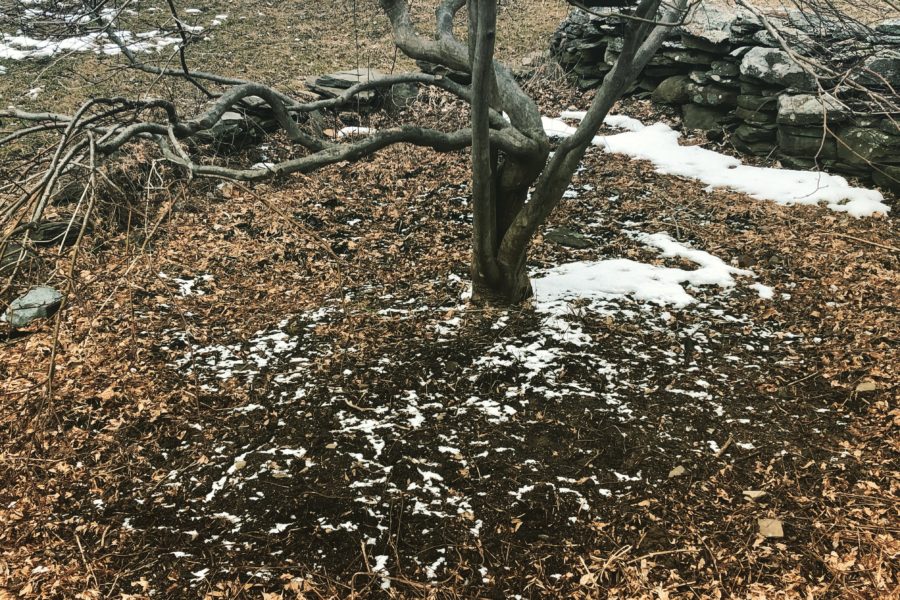Trees in the urban forest are very closely associated with other organisms through matrices of vast symbiotic relationships. For this discussion I am interested in exploring the topic of the beneficial fauna’s role on individual tree sites in the urban forest. Namely, the fauna’s role as a mechanical player at the soil/air interface. I have a very specific question in mind: can we design and influence individual tree site’s in the forest by focusing on beneficial fauna populations in order to achieve more sustainable sites.
This discussion has been inspired by an observation I have made out of my kitchen window. I have two bird feeders in a Japanese Maple tree which I have written about in the past. I witness chickadees, titmice, hairy and red-bellied woodpeckers, flocks of Juncos, Carolina Wrens, Whitebreasted Nuthatches and Cardinals feed at this site. Underneath the feeders at the soil/air interface, the coarse-organic material (leaf litter) has been broken up and worked into the top, organic layer of soil via the mechanical action of the bird activity at the feeders. After noticing the effects of the bird activity in the critical root zone of the small tree, I fancied the idea of birds taking on the role of root zone management and root zone improvement on individual tree sites in the urban forest.
What is it that I am witnessing at these bird feeders? I will again reference the text Ecosystem Management and what it relates in regards to this context. Under the heading Effects of Large Mammal Populations Chapter 6’s author Clive A. David writes that, “Animal influences are generally incorporated into the pools and pathways associated with aboveground biomass, forest floor and coarse woody debris, and soil organic matter. Large mammalian herbivores can facilitate nutrient cycling and ecosystem productivity. They affect both the timing rates of nutrient return to a site and alter nutrient flux patters across the landscape,” (David, 110).
Although this citation discusses the effects of large mammalian influences, I believe my bird feeder observations are a microcosm of the roles animals play in nutrient cycling in the ecosystem at large, which is not only critical for soil health and tree health overall, but especially on potential sites in the urban forest that are more likely fractured from or quarantined from more continuous weave of nature.
The bird feeders provide a form of preferential browse for the bird species and other animals that visit. White tailed deer and squirrels are no strangers to visiting the feeders either, nor are the chipmunks that live in the stone wall bordering the bed. And so my small Japanese maple tree has, quite literally, become a crossroads for many different lives. If biodiversity is a key feature of ecosystem health, than my bird feeders seem to be one of the foundations of biodiversity at this particular site. Or, is it the tree from which they hang? In terms of nutrient cycling, all of this traffic has expedited the breakdown of the coarse leaf litter into the organic layer of soil and supported the aeration process. I am willing to assume that there is another population of fauna within the soil at the microorganism level that further strengthens the example of biodiversity on this site. So then, even on individual tree sites, biodiversity can be encouraged through enticing beneficial fauna to visit, dance around and thrive.
I have more questions than answers. But this seems to be a good approach to the concept I’ve learned from the text known as adaptive management. It’s a philosophy that requires constant data collection and monitoring. As arborists, do you think that we can employ different contractors from the immediate ecosystem to do our bidding for tree health and wellness. We know that mycorrhizae are beneficial organisms critical to nutrient uptake in the dynamic relationship between soil and tree roots. Can we sustainably strengthen individual tree sites by using other beneficial fauna where there are few other options either biologically or financially?
As arborists-as adaptive managers-we can observe how nature works through small windows and try to emulate those processes, in order to better preserve and benefit from those processes, and the larger networks they create.





Leave a Reply
Your email is safe with us.